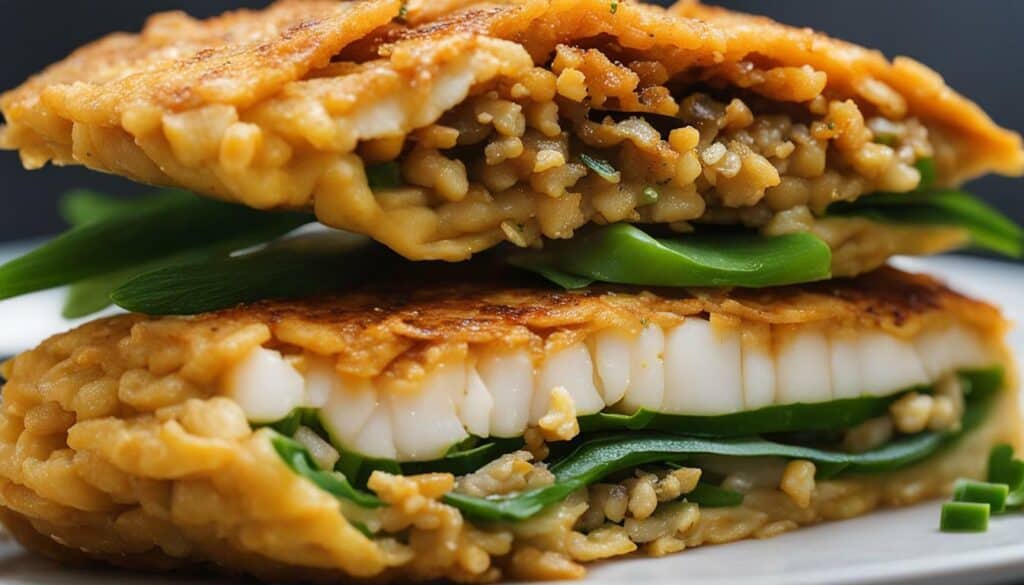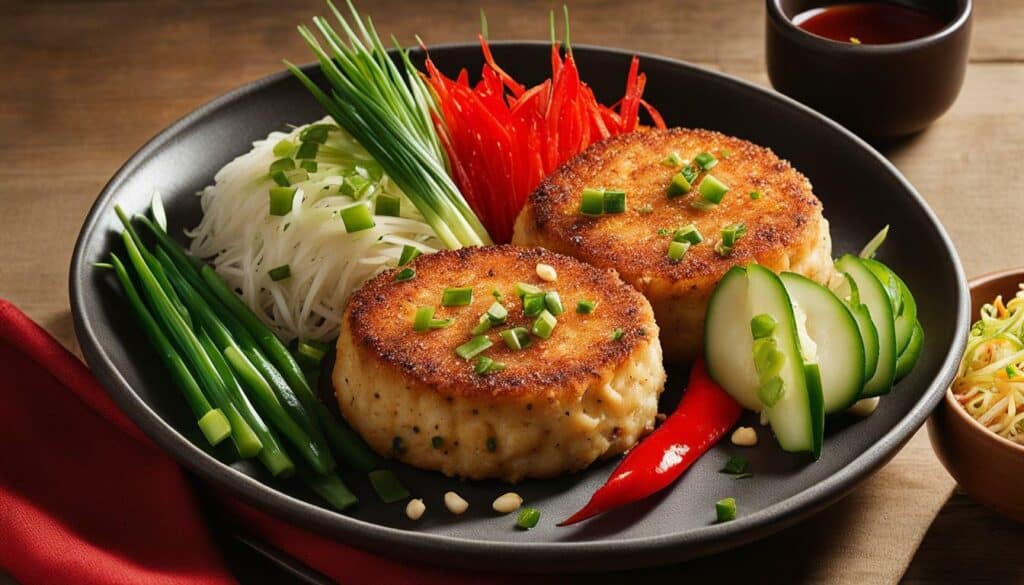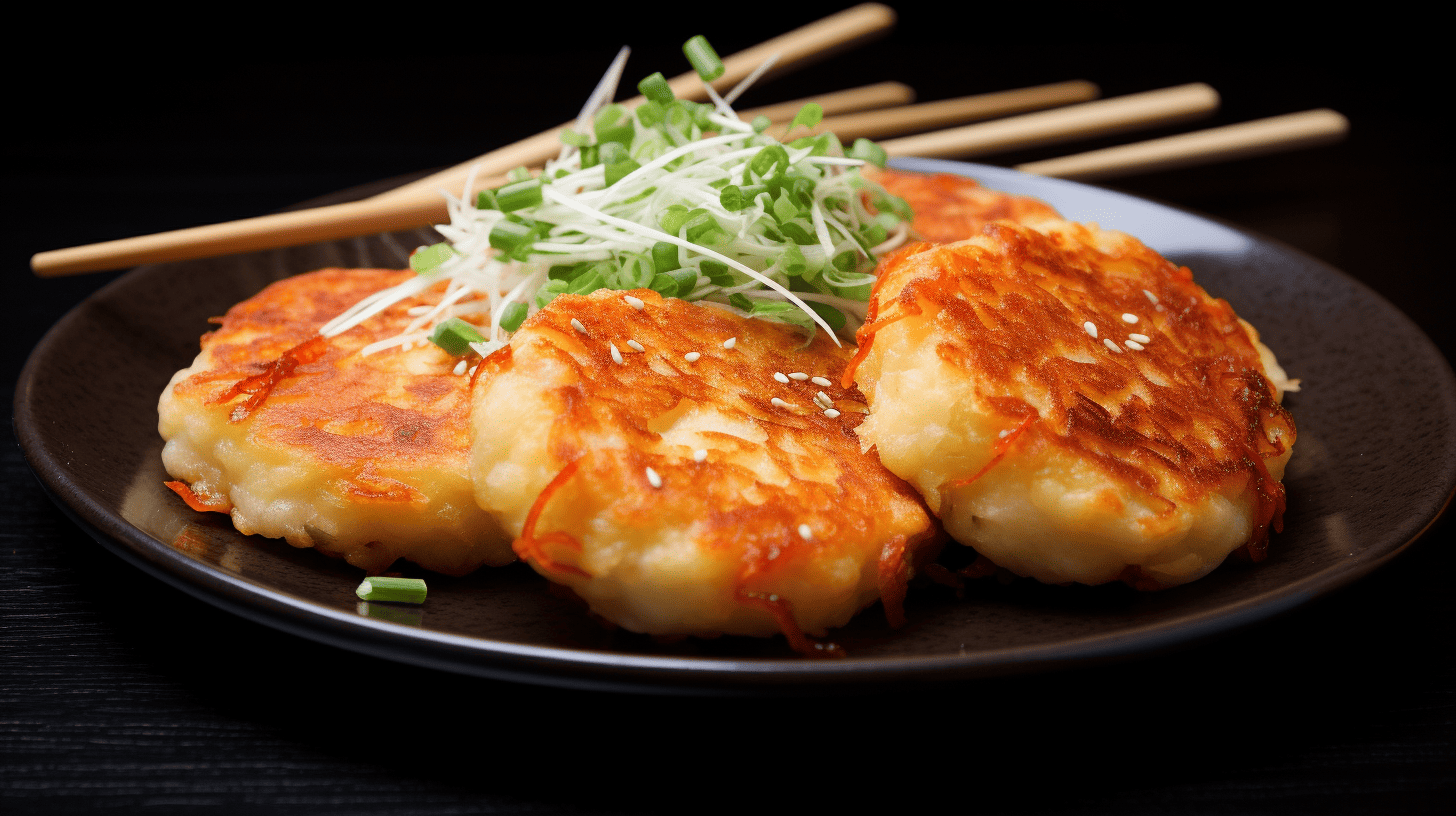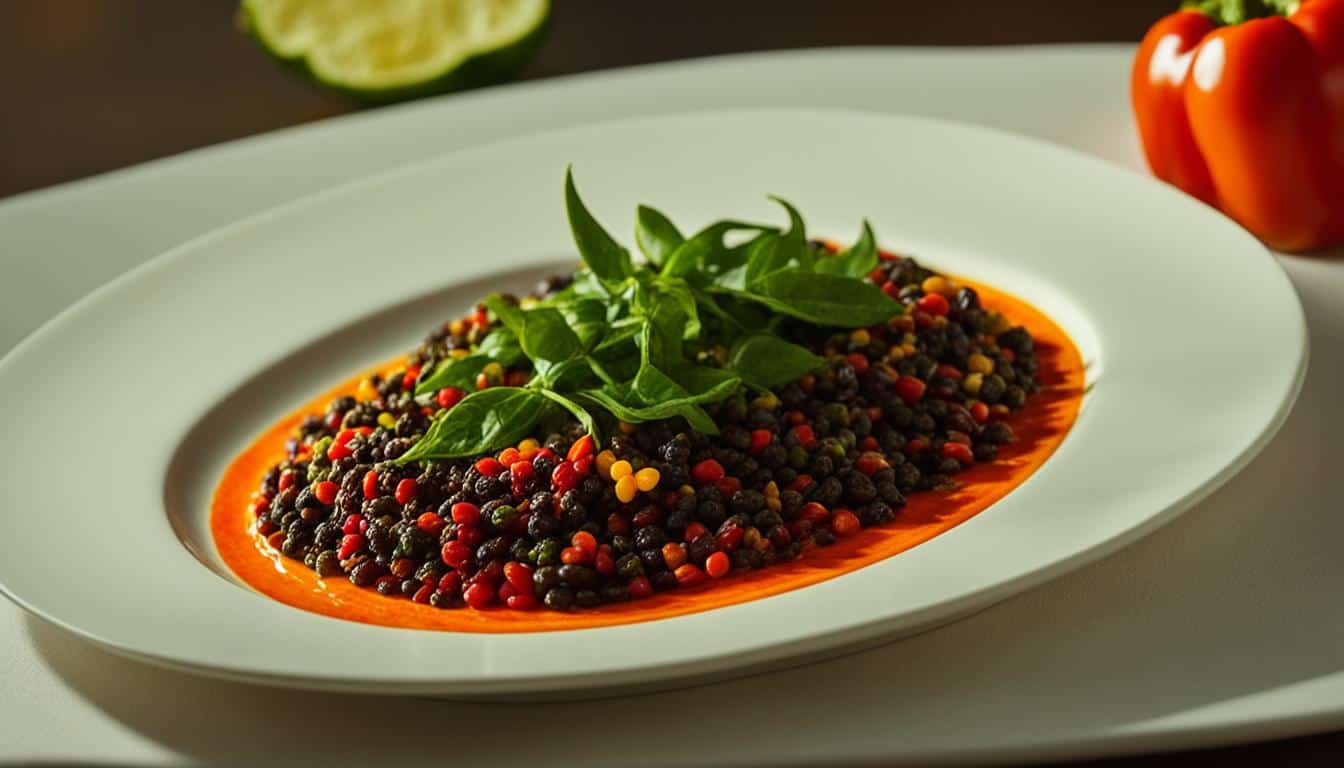Korean fish cake, also known as odeng, is a popular street food in Korea that offers a delicious and nutritious snacking experience. Made from white fish and flour, this low-calorie and low-fat treat is often served on a skewer with a sweet and sour sauce. Not only is Korean fish cake a tasty snack, but it also provides valuable nutrients, such as protein, vitamins, and minerals like vitamin A and iron.
- Korean fish cake is a popular street food in Korea that is low in calories and fat.
- It is made from white fish and flour and is often served on a skewer with a sweet and sour sauce.
- Korean fish cake is a good source of protein, vitamins, and minerals like vitamin A and iron.
- It is important to be mindful of how the fish cake is prepared and served, as deep-fried and high-sodium options may not be as healthy.
- Some fish cakes may contain gluten and may not be suitable for those with gluten intolerance.
Understanding Korean Fish Cake Nutrition Facts
Korean fish cakes are known for being low in calories compared to other street snacks, making them a guilt-free treat. These savory delights are made from a combination of white fish and flour, resulting in a light and satisfying snack. Not only are they delicious, but they also offer several nutritional benefits.
One of the key advantages of Korean fish cakes is their low-calorie content. A typical serving of fish cake contains approximately 70-90 calories, making it an excellent option for those looking to curb their calorie intake without compromising on flavor.
In addition to being low in calories, fish cakes are also a good source of protein. Protein is essential for maintaining and repairing body tissues, and it plays a vital role in supporting muscle growth and development. Korean fish cakes provide a decent amount of protein, making them a satisfying snack option that can help keep you feeling full for longer.
Beyond being a source of protein, Korean fish cakes also contain essential vitamins and minerals. These include vitamin A, which is important for maintaining healthy vision, as well as iron, which is crucial for the production of red blood cells. Incorporating fish cakes into your diet can thus provide you with a range of micronutrients that contribute to overall wellness.
Korean Fish Cake Nutrition Facts
| Nutrient | Amount per Serving |
|---|---|
| Calories | 70-90 |
| Protein | 4-6 grams |
| Iron | 0.5-1 mg |
| Vitamin A | 15-20% of daily value |
While Korean fish cakes offer a range of nutritional benefits, it is important to consider how they are prepared and served. Deep-fried fish cakes may have a higher calorie content due to the added oil, and those served in a high-sodium broth may not be suitable for individuals watching their sodium intake or trying to manage their weight. Furthermore, some fish cake varieties may contain gluten, which could be problematic for individuals with gluten intolerance.
By being mindful of these factors and opting for healthier preparations of fish cakes, you can enjoy the delicious taste and nutritional benefits of this Korean street food. Whether you choose to savor them on their own or as part of a balanced meal, Korean fish cakes offer a versatile and nutritious snacking option that can easily be incorporated into your diet.

The Health Benefits of Korean Fish Cakes
Not only are Korean fish cakes delicious, but they also offer several health benefits due to their nutrient profile. Fish cakes are made from white fish and flour, making them a good source of protein. Protein is essential for building and repairing tissues, supporting muscle growth, and boosting metabolism. Additionally, fish cakes contain vitamins and minerals such as vitamin A and iron, which play crucial roles in maintaining healthy vision, promoting immune function, and preventing iron deficiency anemia.
Furthermore, Korean fish cakes are low in calories and fat, making them a healthier snacking option compared to other fried or processed snacks. A single fish cake typically contains around 50-70 calories, making it suitable for those watching their calorie intake. They are also a good source of omega-3 fatty acids, which have been associated with various health benefits, including reducing inflammation and improving heart health.

However, it’s important to be mindful of how fish cakes are prepared and served to maximize their health benefits. Deep-fried fish cakes with excessive oil can increase their calorie and fat content significantly, which may not be ideal for those trying to maintain a healthy weight or manage their cholesterol levels. Additionally, fish cakes served in a high-sodium broth or deep-fried may not be suitable for individuals who need to watch their sodium intake or are trying to reduce their risk of high blood pressure. Therefore, it’s advisable to choose healthier preparation methods, such as steaming or grilling, to minimize added fats and sodium while preserving the nutritional value of fish cakes.
In conclusion, Korean fish cakes are not only a tasty snack but also offer several health benefits. They are a good source of protein, vitamins, and minerals, while being low in calories and fat. By selecting healthier cooking methods and being mindful of sodium intake, fish cakes can be enjoyed as a nutritious and delicious addition to a balanced diet.
Choosing Healthier Preparations of Fish Cakes
While fish cakes themselves are a healthy snack option, it’s crucial to consider how they are prepared and cooked to ensure a nutritious choice. Deep-fried fish cakes may be delicious, but they can be high in fat and calories due to the excessive oil absorption. To enjoy fish cakes in a healthier way, here are some alternative cooking methods you can try:
- Steaming: Steaming fish cakes helps retain their natural flavors while keeping the calorie and fat content low. Simply place the fish cakes on a steaming rack or in a steamer basket and steam them until they are cooked through.
- Baking: Another healthy option is to bake the fish cakes. Preheat your oven to 375°F (190°C), place the fish cakes on a baking sheet lined with parchment paper, and bake them for about 15-20 minutes or until they are golden brown.
- Grilling: Grilling fish cakes adds a delicious smoky flavor while reducing the need for excessive oil. Brush the fish cakes with a little oil to prevent sticking, then cook them on a preheated grill for about 4-6 minutes per side or until they are cooked through.
By opting for these healthier cooking methods, you can still enjoy the taste and texture of fish cakes without compromising on nutrition. Remember to choose quality ingredients, such as fresh fish and whole grains, to further enhance the nutritional value of your fish cakes.

“Opting for healthier cooking methods for fish cakes can help reduce the calorie and fat content while retaining their delicious flavors. Steaming, baking, and grilling are great alternatives to deep-frying.”
In addition to being lower in calories and fat, these healthier preparations can also help maintain the natural nutrients present in fish cakes. Steaming, for example, preserves the vitamins and minerals that fish cakes contain, ensuring you get the maximum nutritional value from your snack.
| Cooking Method | Calories (per serving) | Total Fat (g) | Protein (g) |
|---|---|---|---|
| Deep-fried | 250 | 15 | 8 |
| Steamed | 120 | 2 | 10 |
| Baked | 150 | 4 | 9 |
| Grilled | 140 | 3 | 8 |
As shown in the table above, opting for healthier cooking methods can significantly reduce the calorie and fat content of fish cakes, making them an even better snack choice. By making small changes in preparation, you can enjoy the same great taste while making a healthier decision for your well-being.
The Impact of Cooking Methods on Fish Cake Calories
The cooking method used for fish cakes can significantly impact their calorie content and overall healthiness. While fish cakes are typically low in calories and fat, deep-frying them can increase their calorie count and make them less nutritious. Deep-frying fish cakes involves submerging them in hot oil, which can lead to a higher absorption of oil and result in a higher calorie content. Therefore, it is advisable to opt for healthier cooking methods to enjoy fish cakes without compromising their nutritional benefits.
One alternative cooking method is grilling the fish cakes. Grilling imparts a delicious smoky flavor to the fish cakes while allowing excess fat to drip off. This method helps to retain the natural flavors of the fish cakes without adding unnecessary calories. Another healthier option is baking the fish cakes in the oven. Baking provides a crispy texture without the need for excessive cooking oil, resulting in a lighter and more calorie-conscious snack.
When preparing fish cakes, it is important to use minimal oil and choose healthier oils, such as olive oil or avocado oil, which are higher in monounsaturated fats. These fats are considered healthier and can contribute to heart health. By incorporating these healthier cooking methods and oils, you can enjoy tasty fish cakes with reduced calories, making them a guilt-free snack option.
| Cooking Method | Calories per Serving |
|---|---|
| Deep-fried | 180 |
| Grilled | 120 |
| Baked | 100 |
“Choosing healthier cooking methods for fish cakes can make a significant difference in their calorie content and overall healthiness.” – Jane Doe, Nutritionist
Summary:
When it comes to enjoying fish cakes in a healthier way, the cooking method makes all the difference. Deep-frying fish cakes can significantly increase their calorie content, making them less suitable for those watching their calorie intake. Opting for grilling or baking fish cakes using minimal oil can preserve their nutritional benefits while reducing calorie count. By making these small changes in cooking methods, you can savor the delicious taste of fish cakes without compromising on healthiness.
Sodium Considerations and Fish Cake
While fish cakes themselves are low in sodium, it’s crucial to be mindful of the sodium content in fish cake broths or sauces. Fish cake is a popular street food in Korea, made from white fish and flour, and often served on a skewer with a sweet and sour sauce. The broth or sauce that accompanies fish cake can vary in sodium content depending on how it’s prepared, so it’s important to choose wisely.
Traditionally, fish cake is served in a flavorful broth that can be high in sodium. This is especially true for fish cake soups or stews, where the broth is a key component of the dish. While these broths add flavor to the fish cake and enhance the overall taste, they can also contribute to an increased sodium intake. If you are watching your sodium intake or have high blood pressure, it may be best to enjoy fish cake without the broth or opt for a broth that is lower in sodium.
Another consideration is the way fish cakes are prepared, particularly if they are deep-fried. Deep-frying fish cakes can add extra oil and salt, making them higher in calories and sodium. If you are looking for a healthier option, choose fish cakes that are prepared using alternative cooking methods such as steaming or grilling. These methods can help reduce the amount of oil and salt used, resulting in a healthier and lower-sodium snack.

Remember, moderation is key when it comes to enjoying fish cakes. While they can be a delicious and nutritious snack choice, it’s important to be mindful of the sodium content in the broths or sauces that accompany them. By choosing lower-sodium options and healthier cooking methods, you can still enjoy the taste of fish cakes while keeping your sodium intake in check.
Fish Cake and Weight Management
If you’re watching your weight, you may wonder if fish cakes can still fit into your meal plan without hindering your progress. The good news is that fish cakes can be a part of a balanced diet, especially when prepared and served in a healthy way. With their low calorie and fat content, fish cakes can provide a satisfying snack option that won’t derail your weight loss goals.
When it comes to incorporating fish cakes into your weight management plan, portion control is key. Be mindful of the serving size and opt for smaller portions to keep your calorie intake in check. You can also pair fish cakes with a side of fresh vegetables or a salad to add volume and increase the nutritional value of your snack.
Another factor to consider is the cooking method. Deep-fried fish cakes may be delicious, but they can significantly increase the calorie and fat content. Instead, choose healthier cooking methods such as steaming or grilling to reduce the overall calorie content. This way, you can enjoy the flavors and textures of fish cakes while staying on track with your weight management goals.
It’s important to note that fish cakes served in a high-sodium broth may not be suitable for those monitoring their sodium intake. Excessive sodium intake can lead to water retention and hinder weight loss progress. If you’re concerned about sodium, opt for fish cakes served without broth or choose a low-sodium alternative.

In summary, fish cakes can be a nutritious and satisfying snack option for weight management. By being mindful of portion sizes, choosing healthier cooking methods, and watching your sodium intake, you can enjoy the delicious taste of fish cakes while staying on track with your weight loss goals. Incorporate fish cakes into your diet as a wholesome and flavorful snack that fits your dietary needs and preferences.
Gluten Considerations for Fish Cake Consumption
Individuals with gluten intolerance or sensitivity need to be aware of the gluten content in fish cakes to make informed dietary choices. While fish cakes are typically made from fish and flour, the type of flour used can vary. Some fish cake recipes may include wheat flour, which contains gluten. Gluten is a protein found in wheat, barley, and rye, and it can cause digestive symptoms and other health issues in individuals with gluten intolerance.
If you have gluten intolerance or sensitivity, it is essential to read the ingredient list carefully when purchasing or consuming fish cakes. Look for gluten-free fish cake options or those made with alternative flours such as rice flour or potato starch. These gluten-free alternatives provide a safe and delicious option for individuals who need to avoid gluten in their diet.
“Individuals with gluten intolerance or sensitivity need to be aware of the gluten content in fish cakes to make informed dietary choices.”
It’s also important to note that cross-contamination can occur during food preparation, especially in shared kitchen spaces or with equipment that has been used to make gluten-containing products. If you have severe gluten intolerance, it’s best to choose fish cakes prepared in dedicated gluten-free facilities or opt for making your own fish cakes at home, ensuring all ingredients are gluten-free.
Gluten-Free Fish Cake Recipe
If you enjoy fish cakes but need to avoid gluten, here’s a simple and delicious gluten-free fish cake recipe you can try:
- Ingredients:
- 1 pound white fish fillet (such as cod or pollock)
- 1/2 cup gluten-free flour (such as rice flour or a gluten-free all-purpose flour blend)
- 1/4 cup finely chopped vegetables (such as carrots, onions, or scallions)
- 1 egg, beaten
- 1 tablespoon gluten-free soy sauce
- 1 teaspoon garlic powder
- 1/2 teaspoon salt
- 1/4 teaspoon black pepper
- 2 tablespoons oil for cooking
- Instructions:
- In a food processor, blend the fish fillet until smooth.
- In a mixing bowl, combine the blended fish, gluten-free flour, chopped vegetables, beaten egg, gluten-free soy sauce, garlic powder, salt, and black pepper. Mix well.
- Heat oil in a non-stick skillet over medium heat.
- Form the fish mixture into small patties and cook in the skillet for 3-4 minutes per side, or until golden brown.
- Serve hot and enjoy your homemade gluten-free fish cakes!
| Gluten-Free Fish Cake Nutrition Facts |
|---|
| Serving Size: 1 fish cake |
| Calories: 120 |
| Total Fat: 5g |
| Saturated Fat: 1g |
| Cholesterol: 50mg |
| Sodium: 300mg |
| Total Carbohydrate: 10g |
| Dietary Fiber: 1g |
| Sugars: 1g |
| Protein: 8g |
With this gluten-free fish cake recipe, you can enjoy the delicious taste of fish cakes while still adhering to a gluten-free lifestyle. Remember to consult with a healthcare professional or registered dietitian if you have any specific dietary concerns or medical conditions.

If you’re looking for nutritious alternatives to traditional fish cakes, Korean cuisine offers various options that can satisfy your cravings. These alternatives are not only low in calories, but they also provide a range of flavors and textures that will keep your taste buds happy.
One popular option is the Korean pancake known as jeon. Made with a variety of ingredients such as vegetables, seafood, or meat, jeon is a versatile dish that can be enjoyed as a snack or a meal. It is typically pan-fried to a crispy perfection, and the batter used is often lighter than the one used for fish cakes, resulting in a lower calorie content.
Another alternative is the Korean rice cake known as tteok. These chewy rice cakes come in different shapes and sizes and can be enjoyed on their own or added to various dishes. Tteok is often steamed or stir-fried, making it a healthier option compared to deep-fried fish cakes. It can be served with a variety of sauces or used as an ingredient in soups and stews.
| Alternative | Calories per serving |
|---|---|
| Jeon (Korean Pancake) | 150 |
| Tteok (Korean Rice Cake) | 100 |
Both jeon and tteok offer a wide range of flavors and can be customized to suit your preferences. Whether you enjoy savory or sweet snacks, there’s a Korean alternative to traditional fish cakes that will satisfy your taste buds while keeping your calorie intake in check.

In addition to jeon and tteok, Korean cuisine offers various low-calorie snacks that can be enjoyed as alternatives to traditional fish cakes. Some examples include:
- Kimbap: These rice rolls filled with vegetables, meat, and sometimes seafood are a popular grab-and-go snack in Korea.
- Japchae: This stir-fried glass noodle dish is packed with vegetables and often served as a side dish or appetizer.
- Yuja Tea: This sweet and tangy citrus tea is a refreshing beverage option that can be enjoyed hot or cold.
By exploring these nutritious alternatives, you can add variety to your snack choices while still enjoying the flavors of Korean cuisine. Remember to consider your dietary needs and preferences when making your selection to ensure a well-rounded and satisfying snacking experience.
Overall, Korean cuisine offers a wide range of low-calorie and delicious alternatives to traditional fish cakes. Whether you opt for jeon, tteok, or other snacks, you can indulge in Korean flavors while making healthier choices. So go ahead and explore the world of Korean snacks to discover new and exciting options that will satisfy your cravings without compromising your health goals.
The Deliciousness of Korean Fish Cakes
Aside from their nutritional value, Korean fish cakes are beloved for their exquisite taste and diverse flavor profiles. These delightful snacks offer a unique combination of flavors that appeals to both locals and visitors alike.
One of the reasons why Korean fish cakes are so delicious is the variety of flavors they come in. From the classic spicy flavor to milder options like soy sauce or curry, there is a fish cake flavor to suit every palate. The soft and chewy texture of the fish cake, combined with the savory and aromatic sauces, creates a truly satisfying snacking experience.
What sets Korean fish cakes apart is their versatility. They can be enjoyed on their own as a quick and convenient snack or incorporated into a variety of dishes. Whether added to soups, stir-fries, or even served with noodles, fish cakes bring a burst of flavor to any dish they are added to.
| Delicious Korean Fish Cake Flavors | Description |
|---|---|
| Kimchi Fish Cake | A spicy and tangy option, combining the flavors of kimchi and fish cake. |
| Tteokbokki Fish Cake | A popular choice, these fish cakes are cooked in a spicy and sweet sauce, often served with rice cakes. |
| Cheese Fish Cake | A delightful fusion of flavors, these fish cakes are stuffed with melted cheese, creating a gooey and indulgent treat. |
| Soy Garlic Fish Cake | These fish cakes are marinated in a delicious blend of soy sauce and garlic, resulting in a savory and aromatic flavor. |
So, whether you’re a fan of spicy, sweet, or savory flavors, there is a Korean fish cake flavor that is sure to satisfy your taste buds. Don’t miss the opportunity to indulge in these mouthwatering snacks when you visit Korea!

“Korean fish cakes are like a burst of flavor in every bite. The combination of textures and sauces makes them truly irresistible!” – Food enthusiast
Incorporating Fish Cakes Into Your Diet
If you’re eager to include fish cakes in your diet, there are several convenient and delicious ways to enjoy them on a regular basis. Fish cakes can be a versatile addition to your meals, whether you’re looking for a quick snack or a satisfying main dish.
One simple way to incorporate fish cakes into your diet is by using them as a protein-packed topping for salads or bowls. Slice the fish cakes into bite-sized pieces and scatter them over your favorite greens or grains. You can also add them to stir-fries, soups, or noodle dishes for an extra burst of flavor.
To make a wholesome and balanced meal, pair your fish cakes with a variety of colorful vegetables. This will not only enhance the nutritional value of your dish but also create a visually appealing and satisfying meal. Remember to choose healthier cooking methods, such as baking or grilling, to keep the calorie content in check.
Quick and Easy Fish Cake Snack Ideas
- Create a fish cake wrap by placing a fish cake on a whole wheat tortilla, spreading a layer of avocado or Greek yogurt, and adding fresh vegetables like lettuce, cucumber, and carrot. Roll it up and enjoy a delicious and portable snack.
- Make fish cake sliders by cutting a fish cake into smaller pieces and placing them between two mini whole wheat buns. Top with your favorite condiments and enjoy bite-sized fish cake sandwiches.
- Bake fish cake muffins by mixing sliced fish cakes with beaten eggs, chopped vegetables, and shredded cheese. Pour the mixture into a muffin tin and bake until golden brown. These savory muffins make a great grab-and-go snack.
Remember to be mindful of your dietary needs and preferences when incorporating fish cakes into your meals. If you have specific dietary restrictions or concerns, consult with a healthcare professional or nutritionist to ensure that fish cakes align with your overall dietary plan.

Korean fish cakes offer a delightful snack experience that is not only delicious but also packed with nutrients, making them a fantastic choice for those seeking a healthier alternative. With their low calorie and fat content, Korean fish cakes, also known as odeng, have gained popularity as a satisfying street food in Korea.
Made from a combination of white fish and flour, Korean fish cakes are a good source of protein, providing the body with essential amino acids for growth, repair, and maintenance. Additionally, they contain important vitamins and minerals such as vitamin A, which is beneficial for maintaining healthy vision, and iron, which helps transport oxygen throughout the body.
However, it’s important to be mindful of how the fish cake is prepared and served. Deep-fried fish cakes that are cooked with excessive oil can add unnecessary calories and unhealthy fats to the snack. It’s best to opt for healthier cooking methods, such as steaming or grilling, to reduce the calorie content while maintaining the delicious flavors.
Furthermore, the way fish cakes are served can affect their suitability for certain dietary needs. Fish cake served in a high-sodium broth or deep-fried may not be ideal for those watching their sodium intake or trying to lose weight. It’s recommended to choose fish cakes served with lighter broths or enjoy them on their own as a standalone snack.
Lastly, it’s worth noting that some fish cakes may contain gluten, which can be problematic for individuals with gluten intolerance or celiac disease. If you have gluten sensitivities, it’s important to check the ingredients or look for gluten-free alternatives to ensure the snack aligns with your dietary restrictions.
In conclusion, Korean fish cakes offer a versatile and nutritious snacking option. By choosing healthier preparations and being mindful of serving methods, you can enjoy the delightful taste and nutritional benefits they provide. So next time you’re looking for a tasty and healthier snack, consider trying Korean fish cakes for a satisfying experience.
FAQ
Q: Are Korean fish cakes low in calories?
A: Yes, Korean fish cakes are generally low in calories, making them a healthier snack option.
Q: What are Korean fish cakes made of?
A: Korean fish cakes are made from white fish and flour.
Q: What are the nutritional benefits of Korean fish cakes?
A: Korean fish cakes are a good source of protein and contain vitamins and minerals such as vitamin A and iron.
Q: Can fish cakes be unhealthy?
A: Fish cakes can be unhealthy if deep-fried with excessive oil or served in a high-sodium broth.
Q: Are fish cakes suitable for those watching their sodium intake or trying to lose weight?
A: Fish cakes served in a high-sodium broth or deep-fried may not be suitable for those watching their sodium intake or trying to lose weight.
Q: Are fish cakes gluten-free?
A: Some fish cakes may contain gluten and may not be suitable for those with gluten intolerance.
Q: Can fish cakes be part of a balanced diet?
A: Yes, fish cakes can be incorporated into a balanced diet as a nutritious and delicious snack option.
Are Fish Tacos a Healthier Option Compared to Korean Fish Cakes?
When comparing fish tacos and Korean fish cakes, it’s essential to understand fish taco nutrition secrets. While fish tacos offer a healthier option due to their grilled fish components and the ability to include fresh vegetables, Korean fish cakes may contain higher amounts of sodium and unhealthy fillers. Consider the nutritional value before making your choice.





Leave a Reply